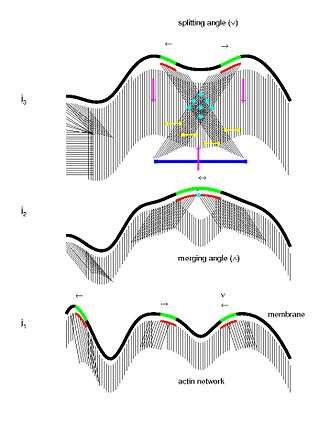Amoeboid movement
Amoeboid movement is the most common mode of locomotion in Eukaryotic cells.[1] It is a crawling-like type of movement accomplished by protrusion of cytoplasm of the cell involving the formation of pseudopodia. The cytoplasm slides and forms a pseudopodium in front to move the cell forward. This type of movement has been linked to changes in action potential; the exact mechanism is still unknown. This type of movement is observed in amoeboids, slime molds and some protozoans such as Naegleria gruberi,[2] as well as some cells in humans such as leukocytes. Sarcomas, or cancers arising from connective tissue cells, are particularly adept at amoeboid movement, thus leading to their high rate of metastasis.
While several hypotheses have been proposed to explain the mechanism of amoeboid movement, the exact mechanism is still unknown.[3]
Molecular mechanism of cell motion

Based on some mathematical models recent studies hypothesize a novel biological model for collective biomechanical and molecular mechanism of cell motion.[4] It is proposed that microdomains weave the texture of cytoskeleton and their interactions mark the location for formation of new adhesion sites. According to this model microdomain signaling dynamics organizes cytoskeleton and its interaction with substratum. As microdomains trigger and maintain active polymerization of actin filaments, their propagation and zigzagging motion on the membrane generate a highly interlinked network of curved or linear filaments oriented at a wide spectrum of angles to the cell boundary. It is also proposed that microdomain interaction marks the formation of new focal adhesion sites at the cell periphery. Myosin interaction with the actin network then generate membrane retraction/ruffling, retrograde flow, and contractile forces for forward motion. Finally, continuous application of stress on the old focal adhesion sites could result in the calcium-induced calpain activation, and consequently the detachment of focal adhesions which completes the cycle.
Another such proposed mechanism, the 'bleb-driven amoeboid locomotion' mechanism, propose that the cell cortex actomyosin contracts to increase hydrostatic pressure inside the cell. The increase hydrostatic pressure causes the cell cortex to be broken in the direction of the desired flow. During the bleb-driven amoeboid movement, the cytoplasmic sol-gel state is regulated.[1]
Locomotion of amoeba occurs due to the sol-gel conversion of the cytoplasm within its cell. The ectoplasm being called the plasma gel and the endoplasm the plasma sol. 'Sol-gel conversion is the contraction and relaxation events which are enforced by osmotic pressure and other ionic charges.'[5]
For example, when an amoeba moves, it extends the gelatinous cytosol pseudopium, which then results in the more fluid cytosol flowing after the gelatinous portion where it congeals at the end of the pseudopium. Inside the amoeba, there are proteins that can be activated to convert the gel into the more liquid state.
Cytoplasm consist largely of actin and actin is regulated by actin binding proteins. Actin binding proteins are in turn regulated by calcium ions, hence, calcium ions are very important in the sol-gel conversion process.[1][5]
Dictyostelium cells and neutrophils can also swim, using a similar mechanism as for crawling.[6][7]
See also
References
- 1 2 3 Nishigami, Yukinori; Ichikawa, Masatoshi; Kazama, Toshiya; Kobayashi, Ryo; Shimmen, Teruo; Yoshikawa, Kenichi; Sonobe, Seiji; Kabla, Alexandre J. (5 August 2013). "Reconstruction of Active Regular Motion in Amoeba Extract: Dynamic Cooperation between Sol and Gel States". PLoS ONE. 8 (8): e70317. doi:10.1371/journal.pone.0070317. Retrieved 29 October 2014.
- ↑ Preston, TM; Cooper, LG; King, CA (Jul–Aug 1990). "Amoeboid locomotion of Naegleria gruberi: the effects of cytochalasin B on cell-substratum interactions and motile behavior.". The Journal of protozoology. 37 (4): 6S–11S. PMID 2258833.
- ↑ R D Allen, and N S Allen. "Cytoplasmic Streaming in Amoeboid Movement" http://www.annualreviews.org/doi/abs/10.1146/annurev.bb.07.060178.002345 Allen, R. D.; Allen, N. S. (1978). "Cytoplasmic Streaming in Amoeboid Movement". Annual Review of Biophysics and Bioengineering. 7: 469–495. doi:10.1146/annurev.bb.07.060178.002345. PMID 352246.
- ↑ Coskun, Hasan; Coskun, Huseyin. (March 2011). "Cell physician: reading cell motion. A mathematical diagnostic technique through analysis of single cell motion". Bull Math Biol. 73 (3): 658–82. doi:10.1007/s11538-010-9580-x.
- 1 2 Rastogi, S.C. (2010). Cell and molecular biology. (3rd ed.). New Delhi: New Age International. p. 461. ISBN 9788122430790. Retrieved 29 October 2014.
- ↑ Van Haastert, Peter J. M.; Hotchin, Neil A. (8 November 2011). Hotchin, Neil A, ed. "Amoeboid Cells Use Protrusions for Walking, Gliding and Swimming". PLoS ONE. 6 (11): e27532. doi:10.1371/journal.pone.0027532. PMC 3212573
 . PMID 22096590.
. PMID 22096590. - ↑ Bae, A. J.; Bodenschatz, E. (4 October 2010). "On the swimming of Dictyostelium amoebae". Proceedings of the National Academy of Sciences. 107 (44): E165–E166. doi:10.1073/pnas.1011900107. PMC 2973909
 . PMID 20921382.
. PMID 20921382.